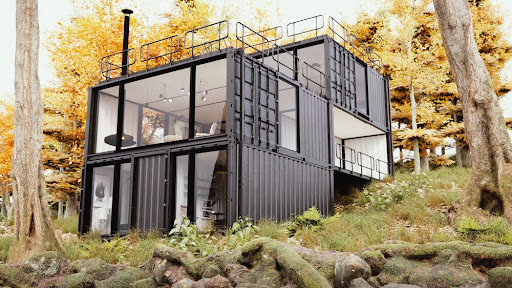Globally Container Houses are gaining mass popularity due to their modern, economical, and eco-friendly feature to cater home as an alternative to traditional housing. Whether in the city or the middle of nowhere, these cool houses are convenient and sturdy. But, as with any option, a container house has some pros and cons.
It is important to consider the advantages and disadvantages of building or buying a container house first before deciding to build. Here is all the information you need.
What Is a Container House?
A container house is the house that is prepared by using act that the house is prepared from shipping container. Shipping containers, ex-novel relocation mode, can, however, be repurposed into hip, functional steel abodes. They can be situated in different land types and adapted with necessary services like insulation, plumbing, and also power.
Why You Should Live in a Container House
Affordable Housing Option
In general, a container house is always less expensive than a traditional. The price relies on the condition and size of the container, as well as what modifications it will must have performed to it. If you own land already, that will cut down on costs a lot.
Many homeowners do a DIY container home conversion to further reduce their costs. But a professional company can help you abide by the building regulations and avoid expensive errors.
Basic container homes start quite low cost but upgrading to luxury features, adding multiple containers, and making more expensive modifications will increase the price.
Quick and Easy Construction
Shipping Containers have walls, floors and ceilings thus need little modification than conventional homes. A good quality, small container house will take no more than three weeks to finish.
If the modifications are completed off-site before setting the container on land, construction is doubly speedy. Yet build times are sometimes held up because of supply chain problems or labor shortages.
Eco-Friendly Alternative
In fact, with the container house environment, it is the type of living that goes less to sustainability. After a few years of use, many containers are disposed of unnecessarily resulting in wastage. Diverting these containers from more aggressive waste streams.
But not all containers are equal. Some are considered “one-trip” containers that have only made a single delivery before being traded, while others have had years of use before entering your local port. This makes choosing an older container a greener option.
Design and scalability flexibility
Standard size shipping containers are 20 or 40 feet in length. They are stackable so you can get fancy with the configuration. Homeowners also can take multiple containers, add windows, doors, or even rooftop decks.
The other benefit is mobility. A container house that weighs less than 10,000 lbs can be moved with a forklift, anything larger calls for a crane. This flexibility makes them an excellent choice for those who have the possibility of a move in the foreseeable future.
Strong and Durable Structure
Shipping containers are designed to endure harsh weather conditions, such as heavy rain, wind, and even earthquakes, as they are primarily constructed from Corten steel. They offer a heavy-duty housing solution with durability and security built in.
A well-maintained container house can stand for decades. Its lifespan can be lengthened with rust-resistant coatings and regular maintenance.
Unique and Modern Aesthetic
A container house has a unique industrial style that can be modified based on the interior and exterior. Homeowners can finish the space with modern touches like lighting and smart home technology to elevate it into a warm, yet modern living environment.
Drawbacks of Container Houses
Even though container houses have benefits, they are not without downsides.
- LESS ENVIRONMENTALLY FRIENDLY WORKING FOR YOU
Everyone is aware now that using old containers is an effective way to reduce waste, but don’t look for ulterior motives here, as not all container house are made of used materials anyway. Most are made using one-trip containers that have not done much to help recycling.
Also remove identification information from these containers as these containers may have been used to transport hazardous materials and thus need to be cleaned and treated heavily before being safe for residential use.
A challenge when it comes to insulation and controlling temperatures
In summer, steel containers can get blistering hot while come winter time, the same steel containers can turn the inside of the container into ice cubes. Insulation is important for making a house livable and that is the same when it comes to container house.
Some common insulation techniques consist of:
- Moisture barrier spray foam insulation
- Budget-Friendly Solutions For Blanket Insulation
- More energy-efficient with panel insulation
- Poor Insulation = Higher Energy Costs
Structural Edits Might Be Essential
Shipping containers are tough, but cutting walls out of them to make doors and windows also compromises the integrity of the container. And, it could also go on to require reinforcements, which can raise construction costs.
In fact, many container houses will often also need a new roof because the original building doesn’t support long term heavy loads.
Building Permits and Zoning Laws
Container houses have a different container home building codes from location to location. In some locales, short of an entire city home, they have special permit requirements about alternative housing.
Building with container homes is far different from your conventional building homes. Before putting on a container home to and your land, homeowners must do the following:
Apply for necessary permits
- Local ordinances can result in costly fines, or worst case scenario, you may have to take the home apart.
Space Limitations
One shipping container is small, so it can be difficult to fit a full kitchen, bathroom, and several living spaces. Combining multiple containers can however resolve this, though it does drive up cost and could be subject to further permitting.
If you live a minimalist lifestyle, then a container house is just right for you. In contrast, in terms of space, space will be quite limited for larger families.
Demand in the resell value and market
The container house space is in its infancy. Although these may appeal to buyers seeking unconventional housing, traditional home buyers may be less open.
Here is what can affect resale value:
- Demand Based on Location – In some regions, there is simply more demand for container homes
- Construction quality – if an insulated, maintained container house exist it will hopefully have a lasting price when you Finally want to sell it
- Market trends – The popularity of alternative housing can wax and wane
You might be waiting longer to sell a container house than you would for a traditional home, but the right buyer can make for a solid investment.
Final Thoughts
Container house is a modern, flexible, affordable living solution. They are also a lot more convenient to erect than a standard home, green, and hardy, but with that convenience comes insulation issues, zoning laws, and installation of supports.
A container house might be an ideal investment for anyone who prefer sustainability, affordability, and a beautiful design. But without planning and research, you may not end up with a successful project.
Are You Considering To Build A Container House? Don’t hesitate and contact us today for an expert guidance from plan to construction that ensures your home is up to your needs and vision.
Get the latest innovations and trends—follow TechFeed!










